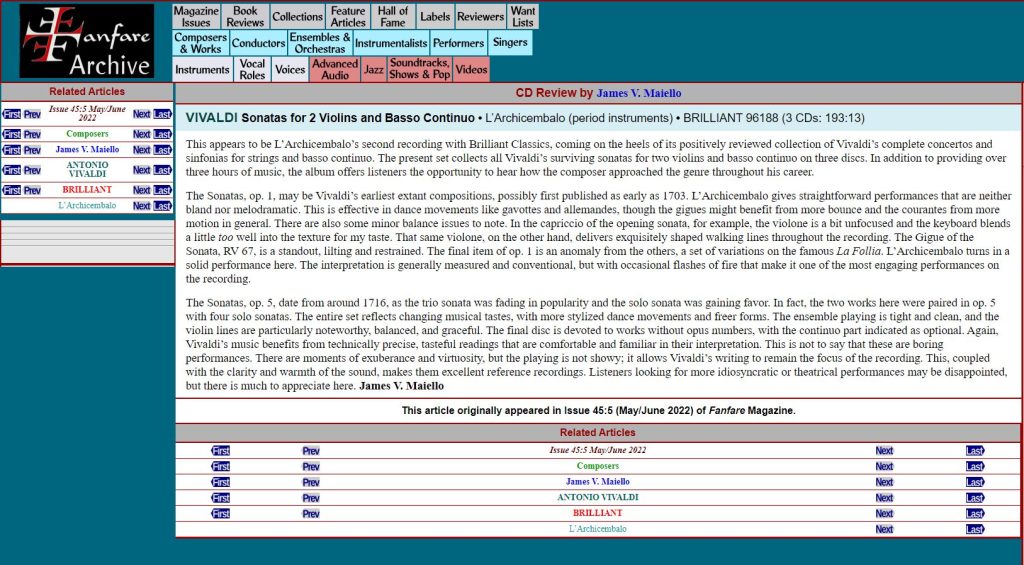Vivaldi: Sonatas for 2 Violins and Basso Continuo – L’Archicembalo
Review by James V. Maiello | Fanfare
This appears to be L’Archicembalo’s second recording with Brilliant Classics, coming on the heels of its positively reviewed collection of Vivaldi’s complete concertos and sinfonias for strings and basso continuo. The present set collects all Vivaldi’s surviving sonatas for two violins and basso continuo on three discs. In addiction to providing over three hours of music, the album offers listeners the opportunity the hear how the composer approached the genre throughout his career.
The Sonatas, op. 1, may be Vivaldi’s earliest extant compositions, possibly first pubblished as early as 1703. L’Archicembalo gives straightforward performances that are neihter bland nor melodramatic. This in effective in dance movements like gavottes and allemandes, thought the gigues might benefit from more bounce and the courantes from more motion in general. There are also some minor balance issues to note. In the capriccio of the opening sonata, for example, the violone is bit unfocused and the keyboard blends a little too well into the texture for my taste. That same violone, on the other hand, delivers exquisitely shaped walking lines throughout the recording. The Gigue of the Sonata, RV 67, is a standout, liting and restrained. The final item of op. 1 is an anomaly from the others, a set of variations on the famous La Follia. L’Archicembalo turns in a solid perfomance here. The interpretation in generally measured and conventional, but with occasional flashes of fire that make it one of the most engaging performances on the recording.
The Sonatas, op. 5, date from around 1716, as the trio sonata was fading in popularity and the solo sonata was gaining favor. In fact, the works here were paired in op. 5 with four solo sonatas. The entire set reflects changing musical tastes, with more stylized dance movements and freer forms. The ensemble playing is tight and clean, and the violin lines are particularly noteworthy, balanced, and graceful. The final disc is devoted to works without opus number, with the continuo part indicated as optional. Again, Vivaldi’s music benefits from technically precise, tasteful readings that are comfortable and familiar in their interpretation. This is not to say that these are boring performances. There are moments of exuberance and virtuosity, but the playing is not showy; it allows Vivaldi’s writing to remain the focus of the recording. This, coupled with the clarity and warmth of the sound, makes them excellent reference recordings. Listeners looking for more idiosyncratic or theatrical performances may be disappointed, but there is much to appreciate here.
James V. Maiello
May/June 2022

Discover the CD Vivaldi – Complete Sonatas for 2 Violins and B.C. here!